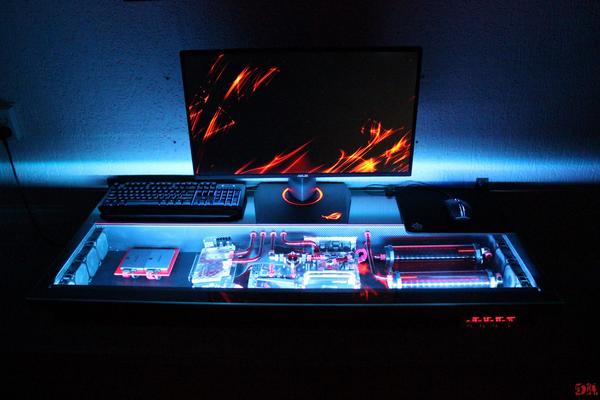How to build a desk PC case
The space-saving advantages and striking look of a desk PC case are attractive, but prefabricated desk cases can be pricey. Building one yourself can save money and give you the perfect custom desk PC for your gaming space.
An easy way to start the process is to envision your perfect desk PC case. After you’ve got a rough idea, make a plan to build it based on the resources available to you. Many people build a desk PC case out of preexisting materials, and others start from scratch with a pile of wood and metal.
Design
Designing your desk PC case is the most critical step. Start by thinking about how much space you have for your gaming setup. Consider what design elements will match the current vibe of that space.
As you design, make a plan for how much desktop space you will need. Mounting monitors above the desk looks sleek and can save valuable desktop space.
Make concrete, detailed plans for how you will build a PC into the desk once it is assembled. Be sure to plan for spacing, mounting the motherboard, and design spaces for fans or another cooling system.
The clear advantage of building your own desk PC case is that you have the opportunity to build it to your exact preferences and specifications. Plan what you want your desk to look like and how it will function to create your ideal gaming or workspace.
Below are some images to inspire your designs.
As you make a design plan, think about the tools you have access to and the materials you will need to finish the build. Make a plan to get the tempered glass, wood, and aluminum or steel that you’ll need to build your desk PC case after the design process.
One of the most important aspects of the design is the internal space that the PC will occupy. As you design the desk PC case, plan where the motherboard will fit and how close critical components like the hard drive and GPU will be. Consider opportunities to showcase some of your PC’s engineering with tempered glass panels.

Plan for comfort and usability just as much as aesthetics. You don’t want to end up with a cool-looking desk that you can’t use. Determine the desktop height, size, and amount of legroom that will make a comfortable gaming or work-from-home setup.
Cooling is a critical part of any PC and PC case. Think about all the design features that gaming PCs use to keep the ambient internal temperature down.
Design your desk PC case with spots for fans and a cooling system. A push/pull system will pull cool air into the case while hot air is pushed out. You might consider a liquid cooling system that can heighten the PC’s overall aesthetic while keeping it cool.
Gather materials
Before you can start to build, you’ll need to gather all the parts for your desk PC case design. You’ll have more control over the design if you start from scratch. You might also use preexisting desk parts, such as steel frames or tempered glass, to save time and money. Working with preexisting desk parts can be a more cost-effective way to build a desk PC case.
Tempered glass can be expensive, and it might be hard to find in the ideal size for your desk. Consider buying tempered glass from the Facebook Marketplace or a used furniture store.
Building with steel will ensure a sturdy frame. Contact a local metalworker if you’d like to have custom pieces of steel cut for your desk PC case. They might also be able to help you assemble your custom desk case for an additional cost.
Wood and aluminum are lighter and less costly but can hold less weight. Be sure that your design specifications are structurally sound for the weight of your PC, monitors, and equipment. Consider reinforcing a wood or aluminum desktop with a steel frame or anti-sag stiffener.
Plan to build
Building anything takes time, space, and the right equipment. Calculate how long it’ll take you to build your desk PC case and set enough time aside for the task. Find a sheltered workspace if you’re working with adhesives. It might take a few days or weeks to finish your project, and you’ll want to keep it out of the elements.
Plan for how you will attach the desktop holding the PC case to the frame of the desk. The connections will have to be strong and sturdy to protect the PC housed in the desk.
How to build your desk PC case
How you go about building your desk PC case depends on the specifications of your design. Here are some tips that will help you as you build:
Setup
Once you have your desk PC case built, you’ll be all set to build your PC into it and set it up. Check that each of the PC components works before you begin loading them into your DIY desk case.
RBG synchronization can make a PC desk shine. Consider using products like keyboards, RAM, fans, and mice that are all the same brand so that they can all be controlled by a single piece of software.
Cable management can make or break an aesthetic. It’s a good idea to build cable management outside of the PC desk so that they aren’t exposed to the heat and can be easily accessed. Attach cable channels or another cable management system to the outside or bottom of your desk PC case.
A 3D printer or some vinyl cutouts will let you customize your desk’s aesthetic theme. Print some design elements to give your setup some of your personality as a final touch.








